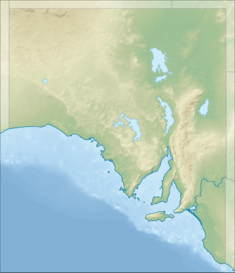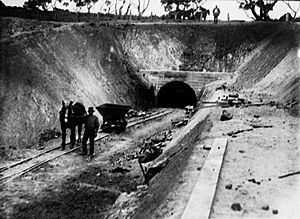Tod Reservoir facts for kids
Quick facts for kids Tod Reservoir |
|
|---|---|
|
Location of the Tod Reservoir in South Australia
|
|
| Location | South Australia |
| Coordinates | 34°28′55″S 135°50′49″E / 34.482°S 135.847°E |
| Construction began | 1918 |
| Opening date | 1922 |
| Dam and spillways | |
| Height | 25 m |
| Length | 351 m |
| Reservoir | |
| Total capacity | 11 300 ML |
| Catchment area | Tod River & Pillaworta Creek |
| Surface area | 134 hectares (330 acres) |
The Tod Reservoir is a large water storage area in South Australia. You can find it on the Eyre Peninsula, near Whites Flat and Koppio. It's about 27 kilometers north of Port Lincoln.
This reservoir gets its water from the Tod River. The Tod River is special because it's the only river on the Eyre Peninsula that flows reliably. Water flows into the reservoir through concrete channels. These channels are fed by weirs built across the Tod River and its main branch, Pillaworta Creek. The river was named after Robert Tod, who found it in 1839. The Tod River eventually flows into Louth Bay in Spencer Gulf. The Tod Reservoir is an important historical site. It is listed on the South Australian Heritage Register.
Contents
Visit the Tod River Reservoir Museum
You can visit the Tod River Reservoir Museum and Picnic Area. The museum has audio and visual displays. It is located off White Flat Road, northwest of Poonindie. The grounds are open every day. You can enjoy a playground, a tennis court, and picnic areas. There are also coin-operated barbecues. The museum itself is open Monday to Friday, from 9 AM to 4 PM.
Building the Reservoir
The idea for a dam on the Tod River came from Mr. C. A. Bayer in 1916. Workers built an earth dam on the Tod River. Construction started in 1918 and finished in 1922. The project cost about $562,000. In 1921, around 600 men worked on building the dam.
The reservoir filled up and overflowed for the first time in August 1932. In 1949, the water level dropped to its lowest point ever. Low water continued to be a problem in 1950. New pumps were installed at the reservoir in 1951 to help with this issue.
Lives Lost During Construction
Sadly, seven lives were lost while the dam was being built. In late 1918, three men died in a cave-in accident. Four more men died in two separate blasting accidents in 1921. A special memorial was put up in 1982. It is located at the picnic area near the dam wall. This memorial remembers all seven men who died.
What is the Reservoir Used For Now?
The Tod River usually provides about 11 gigalitres of water each year. However, this amount can drop a lot during dry periods. For many years, the reservoir supplied up to 3,000 megalitres of drinking water annually. But since 2001-2002, almost no water has been taken for drinking. This change happened because the water became saltier. There were also worries about farm chemicals in the water.
Now, the reservoir is kept as a backup water supply. In 2011, the Department for Water suggested three possible plans for the reservoir:
- Improving the Tod River area to make the water cleaner.
- Opening the reservoir for fun activities like fishing.
- Taking down the dam wall.
Many people on the Eyre Peninsula want to use the Tod Reservoir again for water. They suggest using a process called desalination. This process removes salt from water. SA Water looked into this idea. They decided it was not practical. They said it was hard to find a good place to get rid of the salty waste. They also thought there wasn't enough water in the reservoir to make desalination worthwhile. However, others believe desalination could still work. They suggest more engineering and better water management.
In 2014, the Port Lincoln Times newspaper reported good news. The Tod River Reservoir would be opened for recreational fishing. It would be stocked with fish that people enjoy catching. This change was planned to happen during the 2014-2015 financial year.
Tod Reservoir Facts
Here are some interesting facts about the Tod Reservoir:
- Capacity: It can hold 11,300 megalitres of water.
- Length of wall: The dam wall is 351 meters long.
- Height of wall: The dam wall is 25 meters high.
- Type of wall: It is an earth wall with a clay core inside.
- Area of water spread: The water covers an area of 134 hectares.



